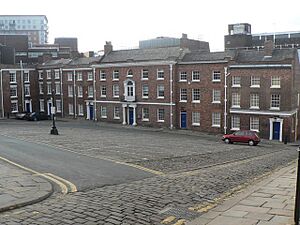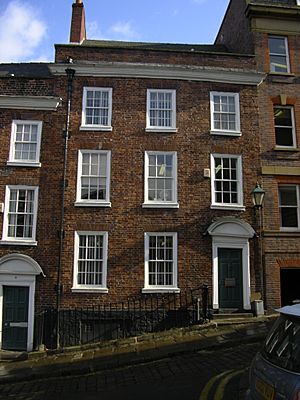Paradise Square facts for kids
Paradise Square is a historic square in Sheffield, England. It's known for its beautiful old buildings from the Georgian era (a time in British history). You can find it northwest of Sheffield Cathedral. The square is built on a slope and was once a popular spot for big public gatherings.
Contents
A Look Back: Paradise Square's Story
Paradise Square was built in the 1700s. It was once a field called 'Hicks' stile-field'. A 'stile' was a special entrance to the churchyard.
Why "Paradise"? And "Pot Square"?
No one is completely sure why it was named Paradise Square. Some historians think "Paradise" or "Parvis" might have meant a garden or a closed-off area near a church.
The area also got the nickname Pot Square. This happened around 1808. It was because sellers of pottery and dishes moved their stalls here from the High Street.
The Buildings of Paradise Square
The houses on the east side of the square were built first. Nicholas Broadbent built five of them in 1736. He leased the land from the people who managed the Shrewsbury Hospital.
His son, Thomas Broadbent, built the other houses. He worked on them from 1771 until about 1790. For example, house number 11 is dated 1787.
Restoring Old Buildings
Some parts of the square were damaged during the Second World War. Between 1963 and 1966, many buildings were carefully fixed. Numbers 18 and 26 were mostly rebuilt. Workers used materials saved from other old buildings.
In the mid-1980s, number 10 was rebuilt. It had been a stuccoed building from the early 1800s. It was given a new look that matched the older Georgian style. All the buildings in the square are very special. They are called Grade II* listed, meaning they are important historic buildings.
Public Gatherings and Speeches
Paradise Square was once a very busy place. People gathered there often to hear important speeches. J. E. Manning, a minister, wrote in 1900 that the square was "often thronged with excited crowds." These crowds came to hear leaders talk about important topics of the day.
The Masonic Hall Balcony
Number 18 in the square had a special room upstairs. This was a Masonic Hall. You could get to it from the square using a staircase. At the top of the stairs was a balcony. This balcony became a stage for speakers at public meetings.
Famous Preachers in the Square
The first big meeting recorded here was on July 15, 1779. John Wesley, a famous preacher, spoke to a huge crowd. He wrote in his journal that it was "the largest congregation I ever saw on a weekday." Later, a special memorial was placed in the square to remember this event. It was unveiled in 1951. Another preacher, Rowland Hill, also spoke in the square in 1798.
Political Meetings and Chartists
Paradise Square was also used by the Chartists in Sheffield. The Chartists were a group of people in the 1800s who wanted more rights for ordinary working people. They held many meetings here.
One important meeting was on September 12, 1839. Troops were sent to break up the crowd. This led to a chase and some arrests. For many years in the 1800s, people running for Parliament in Sheffield would hold their political meetings in the square. The balcony at number 18, used for speeches, was removed in 1889. This pretty much ended the square's use as a big meeting place.
Who Lived and Worked Here?
Even though the pottery market didn't last long, many buildings in the square were used by glass and china sellers throughout the 1800s. The first people to live in the square were mostly well-off professionals. These included lawyers and doctors.
Notable Residents
Some famous people once lived or worked here. Sir Francis Chantrey, a well-known sculptor, had his studio at number 24 in 1802. David Daniel Davis, a doctor, lived at number 12 from 1803 to 1812.
Throughout the 1800s, there were also several inns or pubs in the square. These included the Old Cock tavern at number 11 and the Q in the corner inn at number 17. In more recent years, the buildings have been used as offices. However, in 2008, numbers 7 and 9 were turned into a restaurant.
The Future of Paradise Square
In the future, Paradise Square will be changed into an urban park. This will happen when money becomes available. It is part of the "Grey to Green Scheme." This project was set up by the Sheffield City Council to make the city greener and more pleasant.



